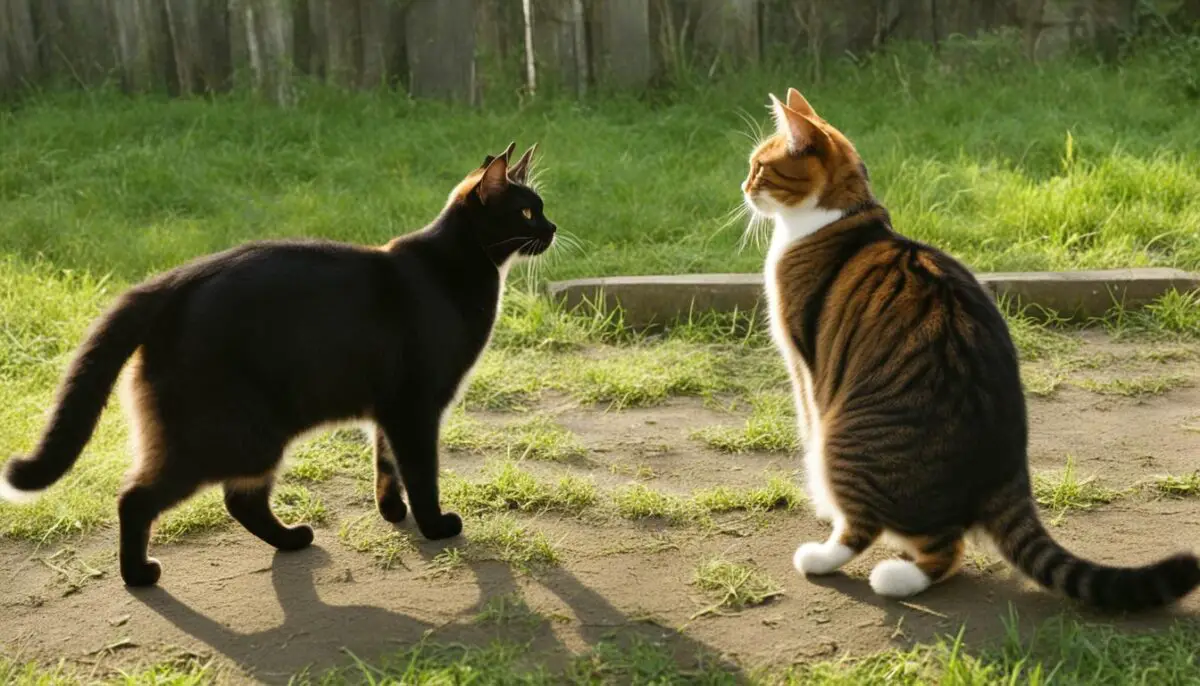Cats fighting and the possibility of them killing each other is a common concern among cat owners. However, it is important to understand that while cat fights can be intense, they rarely result in severe injuries or death. Cats are naturally equipped with weapons like sharp teeth and claws, but their fights are often more about posturing and vocalization than physical contact. Cats fight for various reasons, including territorial disputes, aggression, play, and maternal protection.
While cats can inflict injuries on each other during fights, it is unlikely for them to kill each other. However, untreated wounds from cat fights can become infected, leading to potential complications and even death. It’s crucial for cat owners to be aware of the signs of aggression and take steps to prevent fights and treat any injuries that may occur.
Key Takeaways:
- Cat fights rarely result in severe injuries or death.
- Cats fight for various reasons, including territorial disputes, aggression, play, and maternal protection.
- Untreated wounds from cat fights can lead to complications and even death due to infection.
- It’s important for cat owners to be aware of the signs of aggression and take steps to prevent fights.
- Prompt treatment of any injuries sustained during cat fights is crucial for the well-being of the cats.
Understanding Why Cats Fight
Cats are well-known for their independent and territorial nature, which can often lead to conflicts and fights. To better comprehend why cats engage in these aggressive behaviors, it is essential to explore the reasons behind their territorial behavior, cat fights, and cat hierarchy.
Territorial behavior in cats: Cats are instinctively territorial animals, and fights frequently arise when their territories overlap. By marking their territories with pheromones, cats communicate boundaries and establish a sense of ownership over their space.
Cat fights: One of the primary causes of cat fights is territorial disputes. When another cat encroaches on their marked territory, aggression may ensue. The intrusion is seen as a direct threat to their established ownership, prompting defensive behavior.
Cat hierarchy: Understanding the concept of cat hierarchy sheds light on the dynamics of cat fights. Some cats naturally possess more aggressive tendencies than others, and these dominant individuals may engage in fights to establish and maintain their position in the feline social structure.
Common Causes of Cat Fights
Aside from territorial disputes, there are other common causes of cat fights:
- Play fighting: Cats engage in play fighting as a means of bonding and practicing hunting skills. However, these playful interactions can escalate into fights if one cat fails to acknowledge boundaries or becomes overly aggressive.
- Maternal aggression: Female cats may exhibit aggression when attempting to protect their kittens. This instinctive behavior is a way for the mother cat to ensure the safety and well-being of her offspring.
The Hierarchy in Cat Fights
In a cat fight, hierarchical dynamics become evident:
“When cats engage in fights, their behavior reflects their position in the hierarchy. Dominant cats often display posturing and aggressive body language to establish their authority, while subordinate cats may attempt to avoid conflict by displaying submissive behaviors.”
Understanding the importance of territorial behavior, the potential triggers for cat fights, and the role of hierarchy can help cat owners better manage and prevent aggression between their feline companions.

By implementing appropriate strategies, cat owners can create a harmonious environment and reduce the likelihood of cat fights. The next section will delve deeper into the various ways to manage and prevent cat fights within the household.
How Cats Fight
Cat fights can be intense and involve aggressive body language. During a fight, cats may growl, hiss, and exhibit a twitching tail, indicating their hostility. However, it’s important to note that most fights start with posturing and vocalizations, and physical contact may only occur if one cat does not back down.
Cats use their natural weapons, such as claws and teeth, during fights. However, their intention is typically not to cause serious harm, but rather to establish dominance or defend themselves. Most fights are short-lived, with one cat eventually conceding defeat and backing away.
Cats, even in feral colonies, know that physical fights can lead to injuries that can impact their chances of survival. As a result, fights are usually a last resort for resolving conflicts.
To better understand how cats fight, here’s a table outlining the typical behaviors and actions seen during cat fights:
| Behavior | Description |
|---|---|
| Growling | A low, rumbling sound cats produce to communicate their aggression. |
| Hissing | A loud, sharp sound cats make by forcing air through their teeth to show their hostility. |
| Twitching Tail | A sign of agitation, tension, or readiness to strike. |
| Claws | Cats use their sharp claws as weapons during fights, swiping at each other. |
| Teeth | Bites can occur during fights, but serious injuries are rare as cats do not usually intend to cause harm. |
Understanding how cats fight and interpret their aggressive body language can help cat owners identify potential conflicts and intervene to prevent physical confrontations. By providing a safe and harmonious environment for their cats, owners can minimize the likelihood of fights and maintain a peaceful coexistence.

Do Cats Fight to the Death?
Cats are unlikely to kill each other during a fight. While their fights can result in injuries, the act of killing another cat is rare. The injuries sustained during fights, such as open wounds and puncture marks, can, however, lead to serious complications if left untreated. Cat saliva and claws contain bacteria that can cause infections, and an untreated wound can become infected, leading to ongoing health problems and potential death.

It is crucial for cat owners to monitor their cats for any signs of injuries following a fight and seek veterinary care if necessary. Domestic cats with attentive owners rarely reach the point of severe injury, as wounds can be managed with proper veterinary treatment.
| Injury | Symptoms | Treatment |
|---|---|---|
| Open wounds | Pain, bleeding, swelling | Cleaning, stitching, antibiotics |
| Puncture marks | Small holes, localized pain | Cleaning, antibiotics |
| Infections | Redness, swelling, discharge | Antibiotics, wound care |
Preventing Infections:
- Make sure to clean and disinfect any wounds immediately.
- Apply topical antibiotics to prevent infection.
- Monitor the wound for any signs of infection, such as redness, swelling, or discharge.
- If you notice any signs of infection, seek veterinary care promptly.
“It is crucial for cat owners to monitor their cats for any signs of injuries following a fight and seek veterinary care if necessary.”
By taking prompt action and ensuring proper wound care, cat owners can minimize the risk of infection and ensure the well-being of their feline companions.
Cats Fighting Inside the House
Cat fights can also occur within the confines of a home. To prevent fights between cats, it is important to provide adequate resources and create a harmonious environment.
- Interrupting fights is crucial to prevent escalation, and distracting cats with loud noises or treats can be effective.
- Providing separate resources, such as multiple feeding and water stations, litter boxes, and scratching posts, can reduce competition and prevent fights over resources.
- Spaying or neutering cats can help reduce aggression, especially in unneutered males.
- Rewarding good behavior and offering plenty of enrichment options, such as perches, toys, and scratching posts, can also help reduce aggression.
- Additionally, using synthetic feline pheromones and giving cats their own space can contribute to a more peaceful coexistence.
- If fights persist and become a concern, it is essential for cat owners to seek the help of a professional cat behaviorist.
By implementing these strategies and seeking professional guidance when necessary, cat owners can minimize conflicts between their feline companions and create a harmonious home environment.
Conclusion
Managing cat aggression and dealing with aggressive cats is essential for responsible cat owners. While cats have the potential to fight and harm each other, it is rare for them to cause fatal injuries. With attentive owners who monitor their cats’ behavior and intervene when necessary, domestic cats rarely sustain severe injuries. Preventing cat fights involves providing adequate resources, managing territorial behavior, and promoting positive interactions through enrichment and socialization.
By ensuring that each cat has their own feeding and water stations, litter boxes, and scratching posts, competition and fights over resources can be minimized. Spaying or neutering cats can also help reduce aggression, especially in unneutered males. Rewarding desired behavior and providing plenty of enrichment options like toys and perches can further decrease aggression levels. Additionally, using synthetic feline pheromones and giving cats their own space can contribute to a more peaceful coexistence.
If cat fights persist and become a concern, seeking professional help from a cat behaviorist is highly recommended. These experts can provide guidance in managing aggression and finding specific solutions tailored to the individual cats’ needs. By understanding the nature of cat aggression and taking proactive measures to prevent and manage fights, cat owners can create a harmonious environment for their feline companions, ensuring their well-being and happiness.
FAQ
Can cats kill each other during fights?
While cat fights can be intense, it is unlikely for cats to kill each other. They are more likely to engage in posturing and vocalization rather than causing serious harm.
Why do cats fight?
Cats fight for various reasons, including territorial disputes, aggression, play, and maternal protection. Understanding these reasons can help cat owners better manage and prevent aggression between their cats.
How do cats fight?
Cats use aggressive body language such as growling, hissing, and twitching tails during fights. Physical contact may occur if one cat does not back down, but most fights are short-lived and do not result in serious injuries.
Do cats fight to the death?
While it is rare for cats to kill each other during fights, untreated wounds from cat fights can lead to serious complications if left untreated. Cat saliva and claws contain bacteria that can cause infections.
How can I prevent cat fights in my home?
To prevent fights between cats, it is important to provide adequate resources and create a harmonious environment. This includes interrupting fights, providing separate resources, spaying or neutering cats, and rewarding good behavior.
What if cat fights persist and become a concern?
If cat fights persist, it is advisable to seek the help of a professional cat behaviorist. They can provide guidance and tailored solutions to manage aggression and promote a peaceful coexistence between cats.

